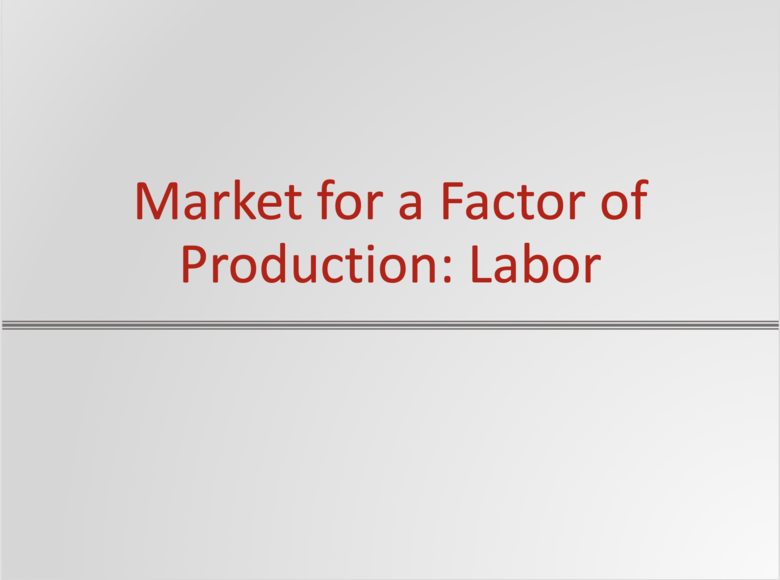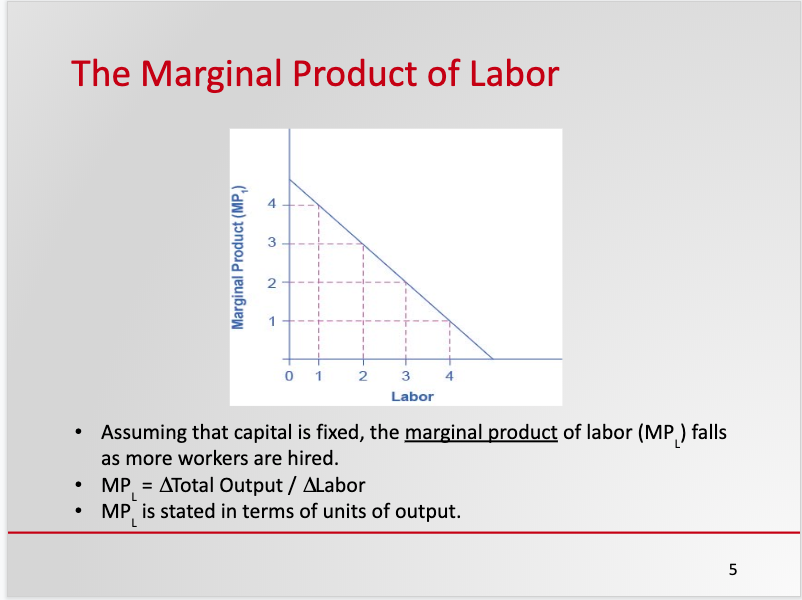Markets for the Factors of Production Resources

Overview
This topic introduces the features of the market for labor, a factor of production. It examines the factors that determine the demand for labor and supply of labor. Equilibrium employment and wages under different assumptions of output and labor market structure are presented. It considers the potential consequences of the minimum wage for workers and employers. Current developments in US labor markets including labor unions, and their implications for trends in wages and earnings are explored.
Learning Objectives
- Explain derived demand for labor (5)
- Explain the marginal revenue product (MRP) of labor and the demand for labor (5, 10, 11)
- Explain the marginal cost of labor and the supply of labor (5, 10, 11)
- Determine labor employment and wages in a perfectly competitive labor market (10,13)
- Determine labor employment and wages in an imperfectly competitive labor market (11, 13)
- Explain equilibrium in the labor market and the factors that shift the demand curve and supply curve of labor (5, 10, 11, 13)
- Discuss the purpose of a minimum wage and its potential consequences (6, 13)
- Identify the role of unions in wage determination (11, 13)
NOTE: This Module meets Ohio TAG's 5, 6, 10, 11 and 13 for an Intro to Microeconomics Course OSS004
Recommended Textbook Resources
Principles of Microeconomics 2e
Full Citation: Taylor, T., Greenlaw, S. et. al. (2017) “Labor Markets and Income” Principles of Microeconomics 2nd Ed. OpenStax CNX.
- Chapter 14: Labor Markets and Income
- Chapter 14.1: The Theory of Labor Markets
- Chapter 14.2: Wages and Employment in an Imperfectly Competitive Labor Market
- Chapter 14.3: Market Power on the Supply Side of Labor Markets: Unions
- Chapter 14.4: Bilateral Monopoly
This resource covers the basic concepts in the economics of labor markets, beginning with the basic theory to applications. It enables students to follow the discussion on how different market conditions have different implications for labor employment and wages. This resource covers all the learning objectives.
This section discusses in more detail factors that shift the market demand curve and supply curve for labor. It outlines the potential impacts of the changes in various factors on equilibrium wages and employment. It provides very good practice and application of demand and supply analysis to a factor market. This resource covers learning objective #6 in more detail.
Supplemental Content/Alternative Resources
Video Resources:
- Marginal Revolution University: The Marginal Product of Labor: This video is an excellent discussion on the basics of the demand and supply curves for labor, both individual and market. It explains a firm’s incentive to employ a labor unit and a worker’s decision to supply a unit of labor. It introduces students to the concepts of derived demand, and marginal product of labor, and explains why there are significant international differences in wages. The reasons for shifts in the demand for and supply of labor could be explored by watching subsequent videos on labor markets.
- Labor Markets and Minimum Wage: Crash Course Economics #28 : This video discusses several concepts on labor markets. It identifies examples of the impacts of demand and supply on equilibrium wages, introduces students to the concepts of derived demand, efficiency wages, and monopsony. Students are briefly introduced to the debates around labor unions and the minimum wage.
Statistical Resources
- Federal Reserve of St. Louis - FRED: This link to FRED database enables students to find and examine historical data on the minimum wage in different states and median real earnings. This is a good way to updates wage and earnings data.
- Bureau for Labor Statistics: This link to the Bureau for Labor Statistics enables students to find comparative wage and earnings data for different occupations and populations in the US.
Active Learning Exercise
FRED Wages Data Exercise
- This link to FRED database enables students to find and examine historical data on the minimum wage in different states and median real earnings.
- Select median real earnings and answer the following questions: what has happened to median real earnings over time (say in the past 20-30 years)? Identify periods of growth and decline, with emphasis on periods of economic expansion and recession. Discuss the reasons for current trends in labor earnings in recent years.
US Department of Labor Exercise
- Current developments in labor markets including regulations can be found by going to the US Department of Labor website at www.dol.gov (Topics or News). Identify current developments in the labor markets by exploring a topical area. Discuss how the developments would impact current and future trends in real earnings and wages.
Questions and Problems
Markets for the Factors of Production: Labor Markets
Questions and Problems
Instructors can add a Google Doc of the Markets for the Factors of Production: Labor Questions and Problems to their Google Drive or download a Word File of the Markets for the Factors of Production: Labor Questions and Problems.
Questions
- Given that the demand for a factor of production is a derived demand, briefly explain how an increase in the demand for automobiles would affect the price of tires (a factor of production).
- If in Ohio certified physician assistants (PAs) are allowed to assume more of the responsibilities of physicians, what would be the impact on the market demand curve and equilibrium wage for PAs?
- Briefly, explain whether you agree or disagree with the following: According to economic theory, a firm should employ labor up to a point where the marginal revenue product equals the marginal cost of labor; therefore, there should be the same employment and wage levels regardless of the competitive structure of labor markets.
- Assume that a firm is a perfect competitor in the labor market. If it is currently employing labor where the marginal product is 8 units, the wage rate is $30, and the output price is $4, can you say that the firm is employing the profit-maximizing unit of labor?
- Technological advance has been a complement to software engineers. If the US government imposes restrictions on all immigration, how would these changes shift the demand and supply curves for software engineers.
- What are some examples of government policy changes regarding labor that would impact the labor market and how?
- Identify at least one reason why the federal minimum wage rate should be increased. Also, identify at least one reason why the federal minimum wage rate should not be increased.
- Labor union participation has been declining in recent years. How do labor unions influence market wages?
Answers
- Since tires add value to automobiles, the demand for tires will increase (shift to the right) and the equilibrium price and quantity of tires will increase.
- In the market of PAs, the market demand curve will shift to the right (demand increases) and the equilibrium wages for PAs will increase.
- Disagree. If the employer is a perfect competitor in the labor market, it employs every unit of labor at the market wage rate which determines its marginal cost of labor. The marginal cost of labor is higher than the wage rate if the firm has market power (e.g. monopsony) in the labor market. While each will hire up to a point where the MRP equals the marginal cost of labor, the imperfect competitor will hire less units of labor and pay lower than the competitive wage rate.
- MPR = 8 X 4 = $32. At a wage rate of $30, the employer may hire an additional unit if the MRP still exceeds the marginal cost of labor.
- As a complement to labor, an advancement in technology will increase the productivity of software engineers and hence increase its market demand curve. However, immigration restrictions will cause the supply curve for software engineers to decrease (shift to the left).
- Increase in the education standard to enter a profession: decrease in supply; requirement of an increase in certain supplements to labor (e.g. health and retirement benefits): decrease in the demand for labor; tax policy to significantly favor investments in capital (technology): if technology is a substitute (complement) to certain kind of labor, a decrease (an increase) in the demand for labor.
- An increase in the federal minimum wage rate will increase the household incomes of families earning the minimum wage to align with overall increases in average price levels and incomes. This is expected to decrease the number of households whose earned incomes place them below the poverty income threshold. An increase in the federal minimum wage rate increases the marginal cost of labor to employers which may cause employers to hire less units of labor.
- Labor unions engage in collective bargaining with employers. If successful, union workers collectively negotiate relatively higher wages, and favorable benefits and supplements to labor. These may be the basis for non-union negotiations and may lead to overall increases in wages to skilled and unskilled labor.
